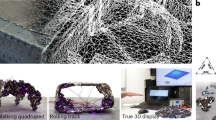Abstract
Morphological Computation is a concept used in robotics that sees physical bodies of robots as means to carry out computations that are relevant for their successful interaction with the environment. It is inspired by observations in nature where we can see that the morphology (i.e. the shape as well the dynamic properties of the body) of biological systems is playing a crucial role for the emergence of intelligent behavior. Although there are a number of successful implementations of this concept in robotics, there are still challenges to overcome. One is that any functionality implemented in a morphology is deemed to be fixed. However, truly autonomous robots should be highly flexible and are expected to be able to adapt to changes in the environment and to new tasks. In case of morphological computation, in order to change the desired computation to be carried out, the underlying morphology has to be altered. A solution is to introduce mechanisms that enable the robot to make these changes online, often referred to as morphosis. We introduce and discuss a general notion of morphosis from the view point of dynamical systems theory, highlight the concept by examples from robotics, and elaborate on the wide-reaching implications with respect to the design of highly autonomous robots.
Access this chapter
Tax calculation will be finalised at checkout
Purchases are for personal use only
Similar content being viewed by others
References
Brown, E., Rodenberg, N., Amend, J., Mozeika, A., Steltz, E., Zakin, M.R., Lipson, H., Jaeger, H.M.: Universal robotic gripper based on the jamming of granular material. Proc. Natl. Acad. Sci. 107(44), 18809–18814 (2010)
Calisti, M., Corucci, F., Arienti, A., Laschi, C.: Bipedal walking of an octopus-inspired robot. In: Conference on Biomimetic and Biohybrid Systems, pp. 35–46. Springer (2014)
Calisti, M., Corucci, F., Arienti, A., Laschi, C.: Dynamics of underwater legged locomotion: modeling and experiments on an octopus-inspired robot. Bioinspiration Biomimetics 10(4), 046012 (2015)
Corucci, F., Calisti, M., Hauser, H., Laschi, C.: Evolutionary discovery of self-stabilized dynamic gaits for a soft underwater legged robot. In: 2015 International Conference on Advanced Robotics (ICAR), pp. 337–344 (2015). doi:10.1109/ICAR.2015.7251477
Corucci, F., Calisti, M., Hauser, H., Laschi, C.: Novelty-based evolutionary design of morphing underwater robots. In: GECCO 2015 (2015)
Corucci, F., Calisti, M., Hauser, H., Laschi, C.: Sha** the body to shape the behavior: a more active role of the morphology in the brain-body trade-off. In: 13th European Conference on Artificial Life (ECAL 2015), Late Breaking Proceedings, pp. 7–8 (2015)
Corucci, F., Cheney, N., Lipson, H., Laschi, C., Bongard, J.: Evolving swimming soft-bodied creatures. In: ALIFE XV, The Fifteenth International Conference on the Synthesis and Simulation of Living Systems, Late Breaking Proceedings (2016, in press)
Corucci, F., Cheney, N., Lipson, H., Laschi, C., Bongard, J.: Material properties affect evolution’s ability to exploit morphological computation in growing soft-bodied creatures. In: ALIFE XV (2016, in press)
Hauser, H., Ijspeert, A.J., Füchslin, R.M., Pfeifer, R., Maass, W.: Towards a theoretical foundation for morphological computation with compliant bodies. Biol. Cybern. 105(5–6), 355–370 (2011)
Hauser, H., Ijspeert, A.J., Füchslin, R.M., Pfeifer, R., Maass, W.: The role of feedback in morphological computation with compliant bodies. Biol. Cybern. (2012). doi:10.1007/s00422-012-0516-4
Hauser, H., Nakajima, K., Füchslin, R.M.: Morphological computation—the body as a computational resource. In: Hauser, H., Füchslin, R.M., Pfeifer, R. (eds.) E-book on Opinions and Outlooks on Morphological Computation, pp. 226–244 (2014). (Chap. 20)
Hermans, M., Schrauwen, B., Bienstman, P., Dambre, J.: Automated design of complex dynamic systems. PLoS ONE 9, e86696 (2014). doi:10.1371/journal.pone.0086696
Johnson, C., Philippides, A., Husbands, P.: Active shape discrimination with physical reservoir computers. In: ALIFE 2014, vol. 14, pp. 176–183 (2014)
Nakajima, K., Li, T., Hauser, H., Pfeifer, R.: Exploiting short-term memory in soft body dynamics as a computational resource. J. R. Soc. Interface 11(100), 20140437 (2014). doi:10.1098/rsif.2014.0437
Owaki, D., Kano, T., Nagasawa, K., Tero, A., Ishiguro, A.: Simple robot suggests physical interlimb communication is essential for quadruped walking. J. R. Soc. Interface (2012). doi:10.1098/rsif.2012.0669
Rieffel, J.A., Valero-Cuevas, F.J., Lipson, H.: Morphological communication: exploiting coupled dynamics in a complex mechanical structure to achieve locomotion. J. R. Soc. Interface 7, 613–621 (2010). doi:10.1098/rsif.2009.0240
Rummel, J., Iida, F., Smith, J.A., Seyfarth, A.: Enlarging regions of stable running with segmented legs. In: IEEE International Conference on Robotics and Automation, 2008, ICRA 2008, pp. 367–372. IEEE (2008)
Shim, Y., Husbands, P.: Feathered flyer: Integrating morphological computation and sensory reflexes into a physically simulated flap**-wing robot for robust flight manoeuvre. In: e Costa, F.A., et al. (ed.) ECAL, pp. 756–765. Springer, Berlin (2007)
Vu Quy, H., Aryananda, L., Sheikh, F.I., Casanova, F., Pfeifer, R.: A novel mechanism for varying stiffness via changing transmission angle. In: ICRA 2011, pp. 5076–5081 (2011)
Vu Quy, H., Hauser, H., Leach, D., Pfeifer, R.: A variable stiffness mechanism for improving energy efficiency of a planar single-legged hop** robot. In: ICAR 2013, pp. 1–7 (2013). doi:10.1109/ICAR.2013.6766488
Vu Quy, H., Ramstein, G., Casanova, F., Aryananda, L., Hoffmann, M., Sheikh, F.I., Hauser, H.: Gait versatility through morphological changes in a new quadruped robot. In: 5th International Symposium on Adaptive Motion of Animals and Machines (2011)
Ziegler, M., Iida, F., Pfeifer, R.: “Cheap” underwater locomotion: roles of morphological properties and behavioural diversity. In: CLAWAR (2006)
Acknowledgments
This works has been partly supported by the EU project RoboSoft—Future and Emerging Technologies Open Scheme (FP7-ICT-2013-C project #619319).
Author information
Authors and Affiliations
Corresponding author
Editor information
Editors and Affiliations
Rights and permissions
Copyright information
© 2017 Springer International Publishing AG
About this paper
Cite this paper
Hauser, H., Corucci, F. (2017). Morphosis—Taking Morphological Computation to the Next Level. In: Laschi, C., Rossiter, J., Iida, F., Cianchetti, M., Margheri, L. (eds) Soft Robotics: Trends, Applications and Challenges. Biosystems & Biorobotics, vol 17. Springer, Cham. https://doi.org/10.1007/978-3-319-46460-2_15
Download citation
DOI: https://doi.org/10.1007/978-3-319-46460-2_15
Published:
Publisher Name: Springer, Cham
Print ISBN: 978-3-319-46459-6
Online ISBN: 978-3-319-46460-2
eBook Packages: EngineeringEngineering (R0)




